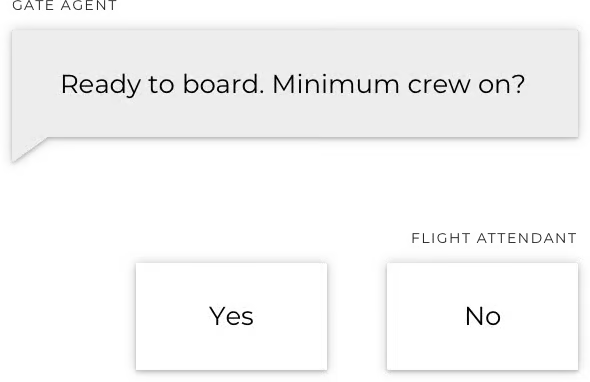Communication Tools Improve Business
Have you ever had the anxiety-inducing experience of being late for a flight and when you got to your seat there was no overhead space left for your bag? You had to make the awkward walk back to the front of the plane to gate check your bag. This is not only frustrating for you, but it also frustrates the airlines by potentially costing them millions of dollars.
In 2018 it cost approximately $75 per minute to operate an aircraft. Every minute spent waiting for your bag to be loaded costs airlines money.
Delta Air Lines rolled out a set of applications called Flight Family Communication (FFC) in 2018 to help tackle flight delays by improving communication amongst employees. By building the FFC app that resides on employees’ existing devices, they were able to remove the reliance on antiquated tools like jetway phones, in-person conversations, or radio messages that could take employees away from their work stations.
As an output of this tool, they have been able to increase the efficiency and improve on-time departures on flights with less than needed ground time by 65%. Are there areas in your business where better communication tools such as FFC could improve associates’ jobs and the company’s bottom line?
In addition to helping Delta implement FFC, BlueFletch has helped a number of other enterprises implement mobile communication tools that are focused on improving employee experience and productivity.
Enterprise Communication Tools are valuable not because of massive one-time savings, but because of the myriad efficiencies gained over the course of a given process or workflow. Knowing when to roll or not roll a truck. Allowing a plane to start gate checking bags because overhead bins are full. Eliminating overtime while employees search for a product in the wrong place.
Tips for Evaluating Enterprise Communication Tools
There are a number of off the shelf tools that help improve communication. You can also build a custom solution tailored precisely to your business similar to what Delta did. As you evaluate leveraging an existing tool or building your own, the following are key questions to consider:
- Role-Based Communication – Map out the roles within your organization. What are the common communications between different roles? Where are there areas where communication could be improved? An example of this would be in a retail scenario where your shoe salesperson has to call the stockroom on a walkie talkie to find out if a particular size is still available.
- User-Based Communication/Presence – Where would it be helpful for your employees to know who is available or who is online?
- Inter-Site Communication – Would an improved process to communicate between sites or locations improve your employee’s experience? A common example of this is a retail location calling another retail location to find out if a particular item is in stock.
- Mediums Used for Communications – Review the mediums your employees are using for communication and understand what types of tooling would help them perform their roles in a more optimized way. Different mediums can be used for different purposes:
- Text – Text messages are great for non-real time communication.
- Audio – Being able to send audio snippets is a good replacement for walkie talkies. Tools like Voxer have popularized sending audio snippets between mobile devices.
- Real-time Voice – Real-time voice is still a great medium for communicating complex items. Phone calls and VoIP are still predominant mediums between employees.
- Images – Similar to voice, sending pictures from mobile devices can be used to clearly describe situations.
- Video – With the advent of front-facing cameras on mobile devices, video has become a great option for communicating very complex topics between employees or even remote support employees.
- Secure Messaging – Will your employees be relaying confidential (PII or HIPAA) or proprietary information? Having a modern communication tool that is properly secured and can audit these communications can lower your legal exposure.

Setting up Comms Tools to Drive Value
There are a few fundamental things you need to be successful at taking advantage of the above items:
- Structure For Efficiency – If you are implementing a text-based component to your solution, take advantage of canned messages and support type-ahead/recommendations for free form messages.
- Implement a Hierarchy Matched to your Business – One of the problems with walkie talkies and radios is that everyone has to hear every message. With modern communication tools, you can build a hierarchy that supports who sees and receives messages.
- Support Message Acknowledge/Read Receipt – Implementing read/acknowledgment functionality reduces anxiety amongst employees and reduces over-communication fatigue.
- Implement SSO/User Awareness – If you have multiple employee tools on your mobile devices, build single sign-on into your communication tool. BlueFletch has built an Enterprise Launcher that uses single sign-on with multiple communication tools (such as Zebra’s WFC). We have found that this SSO process helps prevent employees from “forgetting” to sign onto the communication tools.
- Consider Archival Usage – If you are archiving messages and communications, you can start to take advantage of modern AI and Machine Learning to run message analytics and build a better understanding of the problems your employees are facing.

Small Savings Make Big Savings
Over time, operational wins like the ones described above add up to save lots of money. For example, in Retail:
- Additional Customer Facing Time – If you could give each employee in your company an additional 10 minutes back per day to interact with customers it could add up to millions.
- Improve Processes Like Out of Stock – Better cross-store communications around stock lookups across locations could reduce failed sales due to out-of-stocks (a problem currently costing brick and mortar stores $1 trillion dollars).
- More Efficient BOPIS Experiences – Improved communication around in-store pickup for online orders can allow for a seamless customer experience, the opportunity to cross-sell and save associates from searching for a product.

